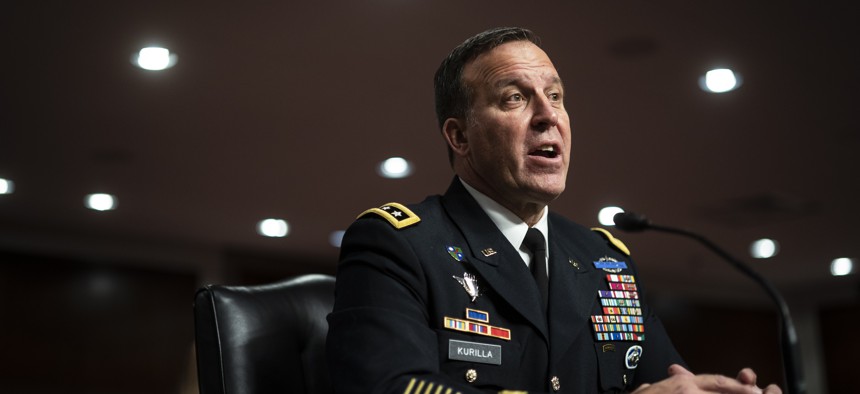
In this 2020 photo, then-Lt. Gen. Michael Kurilla, now commander of U.S. Central Command, testifies before the Senate Armed Services Committee in Washington, D.C. Jabin Botsford/The Washington Post via Getty Images
Threats in the Mideast Are Rising, CENTCOM Chief Says
ISIS-K will be able to launch attacks abroad in less than six months, Gen. Kurilla told lawmakers.
From Chinese firms grabbing a larger share of regional arms sales to Iran’s nuclear efforts, the Middle East is becoming an increasingly challenging security environment, the U.S. general who oversees operations there said Thursday.
Chinese military exports have increased by 80 percent in a decade, said Gen. Michael Kurilla, who leads U.S. Central Command. In the Middle East, these sales have eaten into U.S. market share, said Kurilla, who put some of the blame on Pentagon red tape. While just five percent of U.S. foreign military sales “don’t go to plan,” Kurilla said, most of those cases are in the Middle East.
Chinese military sales representatives, by contrast, make things easy for buyers. They “open their entire catalog, they give them express shipping. They give them no end user agreement, and they give them financing,” Kurilla said, speaking at a hearing of the Senate Armed Forces Committee. “They’re much faster.”
Still, Kurilla said, U.S. partners would prefer to buy U.S. products for their quality and maintenance, adding that the “vast majority” of Chinese weapons are not fit for purpose a year or more after they’re acquired.
U.S. companies still dominate the Mideast arms market, accounting for 54 percent of imports between 2018 and 2022, according to the most recent global-arms report by the Stockholm International Peace Research Institute. They also dominate the global market, accounting for 40 percent of world exports over the past five years. U.S. arms exports rose 14 percent over the past decade—including a 49 percent rise year-over-year rise in 2022, largely due to Russia’s invasion of Ukraine.
Threats from Iran have also increased in the last two years, Kurilla said, citing their progress on enriching uranium, their funding of proxy forces, and drone attacks on neighbors.
Kurilla said Iran proxy groups continue to attack U.S. troops—including a rocket strike by Iranian-backed forces on U.S. troops in Syria less than 60 hours previously. The statement appeared to confirm reports that a March 13 rocket attack on U.S. troops was carried out by Iranian-backed militants.
Kurila also indicated that the capabilities of the ISIS terrorist group had risen.
Discussing ISIS’s Afghanistan branch, ISIS-K, Kurilla said that the group would need less than six months to pull off any attack abroad, although it would need longer for any attack on the United States.
That’s a shorter timeline than Under Secretary of Defense for Policy Colin Kahl gave in October 2021, when he said the group would need at least six months to a year to launch an attack outside of Afghanistan.
U.S. forces have conducted one strike on ISIS-K forces, Kurilla said, and revealed that the U.S. had also conducted two “non-kinetic” operations on ISIS-K.
Access to Afghanistan, though, is a problem. The U.S. is now trying to field high-altitude surveillance assets that can spend weeks observing Afghanistan, with Kurilla saying that U.S. airborne reconnaissance was spending 80 percent of its time just getting to the region.
Kurilla also called out Russia’s increasingly aggressive behavior, where it has maintained a presence since its 2015 intervention in the Syrian civil war. Beginning March 1, Russian ground-attack aircraft began to more frequently buzz U.S. troops, often with weapons attached to their wings, Kurilla said.
News of the buzzing incidents follow a Russian jet’s collision with a U.S. drone over the Black Sea on Tuesday, which resulted in the drone’s destruction. While the U.S. was still determining whether the strike was intentional, the incident fell into a pattern of more aggressive interactions with Russian forces, said Gen. Mark Milley, chairman of the Joint Chiefs of Staff.




